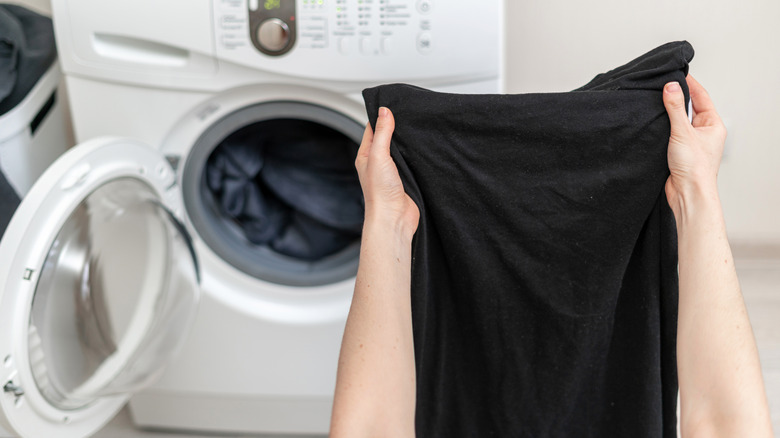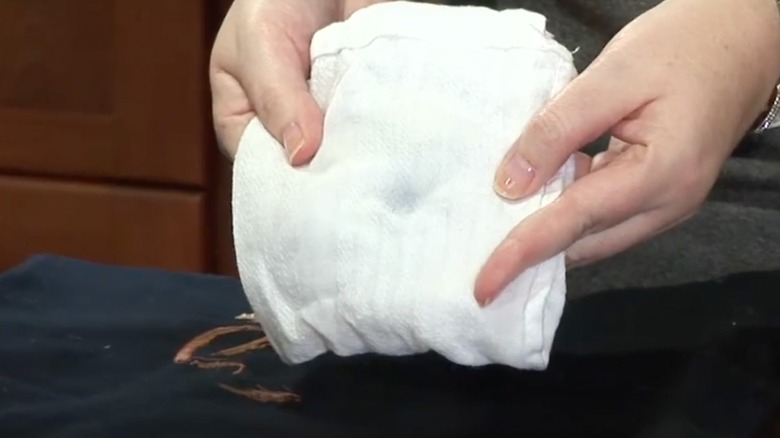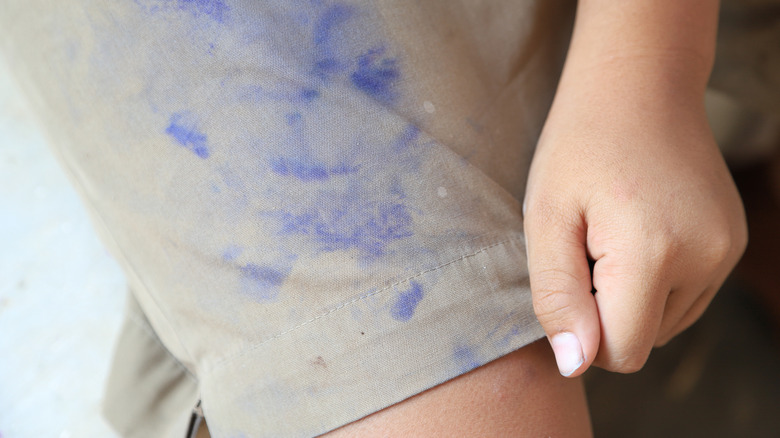Check This Before Washing Dark-Colored Clothes For The First Time
We may receive a commission on purchases made from links.
You've just bought a brand-new pair of dark-colored jeans, and you want to wash them before wearing them. You're tempted to throw them in with the rest of your laundry, but wonder if the dye will transfer to other fabrics. This depends on whether the jeans are colorfast, which means you need to ensure they are before washing them with your favorite T-shirt. The same goes for any dark-colored clothes. But does this mean you have to wash your new items alone, checking to see if the water has any residual dye floating around? Nope. All you need to do is grab a damp cotton swab and wipe the inside fabric hem of your new clothes. If dye transfers to the cotton, you know your items will bleed in the wash.
When clothes are colorfast, they're less likely to transfer dye to other garments. The same goes for your skin if you're wearing something that's not colorfast and it gets wet. The good news is that it only takes a few washes for unstable dye to wash out. Until then, it's important to perform colorfast tests to protect your light-colored clothing from unwanted dye transfer. Although there are steps you can take to clean the worst laundry stains, preventing them in the first place is best, and a quick colorfast check is the way to do so.
Use a cotton swab or white cloth
Your first step is to grab a cotton swab. A white cloth or paper towel will also do, but make sure to only use items you don't mind ruining. Dampen the cotton swab and rub it against your dark-colored clothing. It's best to do this in an inconspicuous location, in case too much dye rubs off. Consider the inside of a seam where the fabric is doubled and a faded spot is less likely to show through. Wipe the area and check to see if any dye transfers to your white fabric or Q-tip. If so, you know your brand-new clothes aren't colorfast.
When trying this trick, you can also apply a little bit of mild soap to your cotton swab, emulating the wash cycle and seeing how the fabrics react to detergent. If you want to take things a step further with this hack, add 1 teaspoon of detergent to 1 cup of water and soak a corner of your clothes. Use a less visible spot, such as a hem. After a few minutes, remove any excess water and wipe your towel or Q-tip against the fabric, checking for signs of color transfer.
You may be able to lock colors in, however, adding vinegar or salt during various stages of your wash cycle. You could even try colorfast sheets when washing clothes, available on Amazon for less than $12. These work to catch dyes before they transfer to other garments.
Why do some clothes bleed?
You can't always prevent clothes from bleeding when washed. It usually depends on the manufacturer and whether they cut corners when making your garments. For example, some textile factories use cheap dyes.Additionally, fabric dyes aren't one-size-fits-all, which means certain fibers require certain types of pigments. When these steps are skipped, the result is clothing without any type of colorfasting. This is why you should always check the label on your garments, checking to see how to wash them. Some labels might say to wash in warm water, cold water, by hand, or to dry-clean only.
The way you launder dark clothes can also affect whether they bleed onto other textiles. For example, cold water tends to prevent dyes from seeping out. That's washing white clothing in warm water and colored clothing in cold water is recommended. But water temperature is only one reason why your dark clothes might bleed in the washing machine. If you're overfilling your washer, the friction between fabrics can loosen dyes, so be mindful of how much you clean at once. As a rule of thumb, filling your washer to no more than 75% of its capacity can work to avoid color transfer. This rule applies when looking for the best way to wash dark colors to keep them from fading and can prevent color transfer from occurring.


